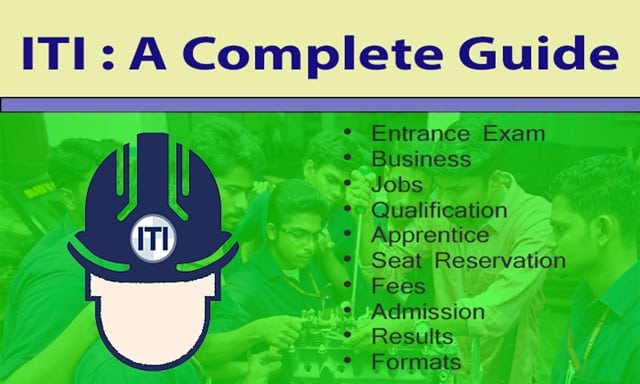
Industrial Training Institutes (ITI), commonly called it is in India, have been at forefront of providing vocational education, employment and entrepreneurial opportunities to millions of women and men across the country.
In India ITIs have a long history: they began in the early 1900s, as small, unorganized training schools operated by nationalists, in a bid to encourage Indians to retain and hone indigenous skills, rather than work at factories belonging to colonial rulers and their cohorts.
Current Scenario of ITI
Currently, every ITI in India operates under the Directorate General of Training at Ministry of Skill Development and Entrepreneurship. ITIs are at the forefront of Skills India and Make in India initiatives launched by the Indian government.
They are providing the much-needed manpower to work in India’s burgeoning industrial growth while promoting entrepreneurship in remotest parts of the country.
At present, there are a total of 12,000 in all states and Union Territories. These include 2,400 institutes are operated by the Central and state governments and some 9,600 authorized facilities are run by the private sector.
Training is imparted in 130 trades – which include some 80 engineering plus 50 non-engineering vocations. Six institutes in the country provide special training for the visually impaired while three are dedicated to providing vocational training in persons with special needs.
ITI Degree
All successful trainees from ITIs are awarded the National Trade Certificate, which is recognized as a vocational educational qualification in India and worldwide.
This certificate is given by the National Council for Vocational Training (NCVT) based in New Delhi. About two million students enroll for the 130 vocational courses annually.
ITI Training Pattern
Vocational training courses offered by ITIs undergo modifications to match industry standards and to ensure employability of graduates. The Central government is entrusted with the responsibility of framing overall policies, norms, and standards as well as examinations for vocational training.
Routine administration of Industrial Training Institutes is the responsibility of the various state governments and administrations of Union Territories.
A typical ITI curriculum includes 30 percent training in theories related to your subject while 70 percent is focused on practical work, individual and group projects as well as skill development.
Admissions to ITIs are done in the month of August of every year based on the criteria that include entrance exam and merit lists that are prescribed annually or periodically by various states and Union Territories.
Basic Qualifications for ITI
In line with Skills India program launched by Prime Minister Narendra Modi’s government on July 15, 2015, the Ministry of Skill Development and Entrepreneurship was formed on November 9, 2014. Subsequently, all ITI training courses came under the purview of this newly formed ministry.
The ministry has stipulated the following basic qualifications for women and men wanting to study ITI courses. The criterion is set in collaboration with state governments and Union Territories administrations.
- Minimum academic qualification from Class VIII (standard eight) to Higher Secondary Certificate (HSC) or equivalent, depending upon the course selected.
- Minimum age of 14 years, maximum 40 years, again based on the course selected.
- Former personnel of Indian Armed Forces, as well as widows of servicemen martyred in action, get a five-year relaxation on the maximum age limit.
- Widows or women separated from husbands or destitute are eligible to join until the age of 35 years. However, they can also avail admissions at the government-run Craftsmen Training Centers in India.
- The maximum age limit for persons with special needs (physical disabilities) is fixed at 35 years.
ITI Seat Reservations
In line with Central and state government policies, seats at every ITI are reserved for underprivileged sections of the Indian society. The number of seats reserved per institute and for every course solely depends upon the state government.
This is to ensure that a maximum number of underprivileged people get opportunities to raise their standard of living and, in some cases, rise above the National Poverty Line.
- Seats are reserved for applicants from Scheduled Castes, Scheduled Tribes, and Other Backward Classes. The number of seats depends upon the percentage of such population in each state. Hence, these are fixed by the state government annually.
- As part of empowering women, 25 percent seat at all ITIs are reserved for women.
- Some seats are reserved for girls and boys living and referred by orphanages and juvenile correction centers.
- Physically challenged persons can enroll at ITIs under the Craftsmen Training Scheme and Apprentice Training Scheme. However, such applicants have to produce Certificate of Eligibility or Certificate of Fitness from a specialist doctor from any government hospital. The certificate has to explicitly state the applicant is physically and mentally undergo the training. Three percent seats at ITIs are reserved under this category.
- Under latest rules, 10 percent seats are available to children and dependents of Indian Armed Forces personnel under four categories. These seats can be availed by children or widows of servicemen killed or handicapped in action during peacetime or major conflicts, children of ex-servicemen as well as Indian Armed Forces personnel and officers currently in active service.
ITI Entrance Exam
To undergo any training course at ITI, you have to pass an entrance exam. These exams are held during the month of August every year. In some states, applications for ITI entrance exams are done twice a year- in April and August, they are conducted by technical education departments of state governments. You will need:
1– A scan of your passport type photograph.
2– Scanned copies of your signature that can be verified if required.
3– Some states make it mandatory to submit Aadhar card number and details.
Applying for ITI Entrance Exam
Here we explain the process of applying for ITI entrance exam.
- Go to the portal of your state government and click on the appropriate link.
- Register yourself online, using a valid email ID and mobile number
- You will receive a One Time Password (OTP) for your registration. Upon entering this OTP, you will be directed to fill other details.
- Fill in the required details including your name, date of birth, address, contact details and educational qualifications, among others.
- Review the application form before submission and correct errors if any.
- Submit the online application.
- The portal will ask you to pay fees online using credit/ debit card or net-banking.
- You can pay exam fees at any designated banks by your state government and obtain a receipt. Details of this receipt, also called ‘challan’ have to be entered while completing the online application form.
Upon successful submission of the application, you will receive an email and a unique ID and password to access the portal for future use.
ITI Entrance Exam Fees
According to latest notifications by various state governments, all ITI aspirants have to pay a nominal entrance exam fee as follows:
- Applicants in General category: Rs.250.
- Applicants from Scheduled Caste, Scheduled Tribes, Other Backward Classes: Rs 150.
- Exemptions are available under certain categories and are notified on the web portal of every state annually. Generally, students referred by orphanages/ juvenile correction homes, war widows, children of servicemen martyred or handicapped in action are often exempted from paying ITI entrance exam fees.
- Physically challenged, visually impaired persons are also offered exemption from paying ITI entrance exam fees by certain states and Union Territories.
ITI Entrance Admit Card
Upon successful registration, you will receive e-mails from your state government regarding exam dates and other relevant information. You will also be notified of the date when you online admit card will be available online.
- ITI Entrance Admit Cards are generally issued within a fortnight of your successful application.
- Download and print the ITI Entrance Admit Card.
- Get the ITI Entrance Exam Admit Card attested by any senior officer of the Central or state government. Branch managers of Public Sector Undertaking (PSU) banks, postmasters at India Post offices and in some cases, principals of government schools and colleges can also attest your ITI Entrance Admit Card.
- Remember, without a valid Admit Card endorsed by a senior government official, you will be denied entry to the examination center.
- Damaged, stained or blurry prints of ITI Entrance Exam Admit Card are not accepted for entry into the examination center.
ITI Entrance Syllabus
Since all states in India are at various stages of development, ITI entrance exam syllabus also varies and is designed to suit applicants who have studied at government schools.
The syllabus is rather simple. Questions asked will be from your school curriculum. Additionally, you will also have to read newspapers and general knowledge books to pass certain other papers of the ITO Entrance.
Across India, the ITI syllabus centers around four main subjects:
- General Knowledge: This section of the ITI Entrance Exam deals with news and current affairs, knowledge about the Indian economy, names of ministers, history, geography and related topics.
- Mathematical Skills: This can be fairly complex and you will need to be well versed with Greatest Common Denominator, Least Common Factor, algorithms, logarithms, various mathematical and geometrical theorems, decimal fractions, compounding, profit and loss calculation and balance sheet maintenance among others.
- Basic English Language Skills (Verbal and non-verbal): This includes English language basics as you would have studied at school. Sentences used in writing answers to questions on the paper will count. Additionally, you will undergo a verbal test where you will be asked to speak in English.
- Verbal and Non-Verbal Intelligence: This includes a test of skills like problem-solving, coding and decoding sentences, forming or solving diagrams, reading graphs and other tests. Questions will also be asked during the verbal format of this exam in an interview form.
ITI Entrance Exam Format
As explained above, a typical ITI Entrance Exam covers four main topics in verbal and non-verbal exams. Some basics you should bear in mind are:
- Duration of an ITI Entrance Exam is three hours (180 minutes).
- You have to answer a total of 100 questions. The number may differ on every question paper.
- All questions are multiple choice- meaning, you have to choose the answer from the given set.
- Four marks are given for every correct answer.
- There are no negative marks for wrong answers.
It is important to bear in mind that ITI Entrance Exam formats differ in every state. Further, some states like Maharashtra also have different question papers for various courses such as engineering, non-engineering and vocational.
NOTE: Under revised laws in some states, candidates for ITI Entrance Exams are permitted to answer General Knowledge/ General Aptitude, Mathematics and Non-Verbal Intelligence papers in the official language. English, however, is compulsory.
Preparing for ITI Entrance Exams
Never take an ITI entrance exam lightly. They are very complex and you will need to exert extra efforts to pass them and appear on the merit list. Below are some guidelines that can help you successfully crack ITI Entrance Exams and get you on the merit list.
- Revise mathematics and geometry lessons you learned during school days and if applicable, till HSC or its equivalent. Mathematics is the subject where most ITI aspirants flounder.
- Read English newspapers to brush up your spoken and written skills in this foreign language.
- Acquire general knowledge about news and current affairs by reading newspapers. Get a good general knowledge publication such as the latest Manorama Yearbook that carries such vital information.
- Intelligence tests can be passed by solving puzzles, quizzes and other stuff that feature in daily newspapers.
- Read ITI Entrance Exam papers of the last three years available online to acquaint with the nature of featured questions.
- Departments of vocational and industrial training of various Indian states and Union Territories contain a goldmine of information on past exams, question papers, tips and tweaks for ITI aspirants.
NOTE: Nowadays, thousands of classes that offer the coaching on how to crack ITI Entrance Exams have mushroomed across India. We decline comment on the quality of coaching imparted by these privately run classes. However, in some states, familiarization sessions to crack ITI exams are held by the department that conducts the exams. You can attend such familiarization programs.
ITI Entrance Exam Results
Results for ITI Entrance Exams are generally announced in the month of September in most states. However, where exams are held twice a year, results are generally declared in May and September.
ITI Results are published online, through web portals of a department of vocational training of various state governments. Additionally, announcements about results being declared may also feature in some newspapers or regional TV channels.
You will receive the email from the government authority that conducted the ITI Entrance Exam to check your result online.
ITI Merit List
Exam results, like any other, are published in the form of students that are successful or have failed. However, ITI Entrance Exam results also include a merit list.
This means, the number of applicants who have scored the highest marks required to gain admission to a specific course at ITI. Hence, it is extremely vital that your name features on the ITI Exam Merit List.
Admission to ITI Courses
Admission to all ITI courses is purely on basis of the ITI Exam Merit List. Meaning, aspirants that have scored highest will be given priority in admission for the chosen course. Highest scorers stand the best chance.
Your name and admit card number may appear in the ITI Exam Merit List. However, if there are students that have scored more than you, they will automatically be given priority. Thus, you may lose the chance of studying for a chosen course at ITI or be put on the waiting list.
This means, if a student who is getting admission on priority does not enroll for any reason, you may get the seat. Getting a seat on the waiting list also depends upon your scores at the ITI Entrance Exam.
Depending upon which state you reside, you can be offered a seat in an ITI that is away from home, should you fail to secure one due to lower marks.
Shortage of ITI Seats
According to a report carried on June 20, 2017, by India’s top English newspaper, Indian Express, there is an increase of 14.64 percent in demand for ITI seats while employability of those completing their courses successfully has risen by some 8.02 percent.
This figure was released by Maharashtra’s Department for Vocational Education and Training (DVET). However, statistics can differ according to every state.
Conflicting reports claim that students are losing interest in ITI because employability is low. Understandably, this can occur in some states that are industrially backward or where entrepreneurship is low for any reason.
ITI Courses
As mentioned earlier, there are some 130 engineering and non-engineering courses available through ITIs across India. Here, we provide a list of these ITI courses. Remember, some courses may not be available in your state.
- Machinist
- Turner
- Fitter
- Air Conditioner and Refrigerator Mechanic
- Mechanic Machine Tools
- Machinist Grinder
- Instrument Mechanic
- Tools and Die Maker (General)
- Mechanic Diesel Engine
- Craftsman Mechanic
- Draftsman Civil Surveyor
- Electrician
- Electroplater
- Computer Operator and Programming Assistant
- Electrician (Power Distribution)
- Electronics Mechanic
- Mechanic Motor Vehicle
- Plastic Processing Operator
- Tools and Die maker (Die and Molds)
- Computer Hardware and Network Maintenance
- Surface Ornamentation Techniques (Embroidery)
- Basic Cosmetology
- Commercial Art
- Desk Top Publishing Operator
- Digital Photographer
- Draughtsman (Architecture and engineering)
- Dress Making
- Mobile Phone Mechanic
- Fashion Design & Technology
- Food & Beverages Service Assistant
- Craftsman Food Production (General)
- Health Sanitary Inspector
- Information Technology & Electronic System Maintenance*
- Draughtsman (Mechanical)
- Draughtsman (Civil)
- Stenography (English)
- Secretarial Practice
- Mechanic Motor Vehicle (Agricultural Vehicles)
- Hair & Skin Care
- Craftsman Food Production (Nutrition Assistant)
- Steward
- Mechanic Diesel
- Welder (Gas and Electric)
- Carpenter (Office Décor)
- Wireman (Domestic)
- Industrial Plumber
- Cutting & Sewing (Tailoring Factory)
- Hospitality Management-Broad Based Basic Training
- Hospitality Management-Advanced Modules (Food Production)
- Hospitality Management-Advanced Modules (Front Office Management)
- Hospitality Management-Advanced Modules (Food & Beverage Service)
- Hospitality Management-Advanced Modules (House Keeping)
- Production and Manufacturing-Broad Based Basic Training
- Production and Manufacturing-Advanced Modules (CNC Machining)
- Production and Manufacturing-Advanced Modules (PLC & Automation)
- Information Technology-BBBT
- Information Technology-Advance Modules (Hardware & Maintenance)
- Information Technology-Advance Modules (Multimedia & Web Designing)
- Information Technology-Advance Modules (Computer Networking)
- Fabrication (Fitting & Welding)-Broad Based Basic Training
- Fabrication (Fitting & Welding)-Advanced Modules (TIG/MIG Welding)
- Fabrication (Fitting & Welding)-Advanced Modules (Pressure Vessel & Pipe Welding)
- Fabrication (Fitting & Welding)-Advanced Modules (Welding Inspection & Testing)
- Automobile-Broad Based Basic Training
- Automobile-Advanced Modules (Servicing & Overhauling of Automobiles-Petrol)
- Automobile-Advanced Modules (Servicing & Overhauling of Automobiles-Diesel)
- Automobile-Advanced Modules (Auto Electrical Electronics & Air-Conditioning in Automobiles
- Automobile-Advanced Modules (Overhauling of Fuel Injection System & Steering Mechanism)
- Automobile-Advanced Modules (Denting, Painting & Welding
- Electrical-Broad Based Basic Training
- Electrical-Advanced Modules (Repair & Maintenance of Domestic Appliances)
- Electrical-Advanced Modules (Operation & Maintenance of Equipment used in HT, LT, Sub-station and Cable Jointing)
- Electrical-Advanced Modules (Repair & Maintenance of Electrical Machine & Power Supply)
- Data Entry Operator (Short Term Course)
- Driver cum Mechanic-Light Motor Vehicle (Short Term Course)
NOTE: The above list is not complete. There are several more courses available from ITIs depending upon the state. Special courses are available for those with special needs as well as adult women and men who are uneducated.
Fees for ITI Courses
Fee for an ITI course depends upon its nature and duration. Engineering related course at ITI costs between Rs.50,000 to Rs.100,000 for two years. Non-engineering courses are priced between Rs.20,000 and Rs.50,000. Other short-term vocational courses vary between Rs 5,000 and Rs.10,000.
Fee exemptions are allowed in certain cases for students from economically backward sections of the society, war widows, as well as children of Indian soldiers, martyred in action in conflict or peacetime operations. These depend according to every state.
ITI Apprentice
While studying at ITIs, you will be approached by local companies and businesses to work as an apprentice. Often, the ITI will have agreements to provide apprenticeship to students. The system works purely on merit. However, every student gets opportunities to become an apprentice while studying.
Some companies may retain your services and make you a full-time employee upon successful completion of the course. The Ministry of Skills Development and Entrepreneurship also provides some assistance to ITIs to assistance from the corporate sector for placements of apprentices.
Industrial Training Institute Locations
As mentioned earlier, there are more than 12,000 ITI registered across India. The number of government and private run ITIs, as well as seats available, can be found on the Directorate General of Training website. This list is merely indicative since several new ITIs have opened in all states over the last four years.
To find names and location of the nearest ITI, you will have to visit the website of the vocational training department of your native state.
For example, Department of Vocational Training is the authority that regulates ITIs in Maharashtra. You can also find comprehensive information about courses offered in the state ITIs there.
ITI Jobs
There are several types of jobs available to women and men who successfully complete an ITI course.
- Jobs as instructors or teaching assistants at ITI. (Government and Private Sector)
- Rural workers (State Government to promote vocational trade in villages)
- Social Workers (Charity organizations who conduct training to educate women and men in underdeveloped regions of India)
- Government Jobs (With various departments, PSUs, and ministries)
- Airlines
- Hotels & Restaurants
- Electronics and Home Appliance manufacturers.
- Garment manufacturers
Business after ITI Course
Under Skills India, ITI degree holders can avail of loans under the Micro Units Development and Refinance Agency (MUDRA) Bank scheme from PSU banks, authorized Non-Banking Financial Companies and others to launch your own micro or small industry.
Additionally, you can open your own private ITI in your area to offer training in the course you specialized, provided you meet certain criteria.
Details regarding opening an ITI can be found at the Directorate General of Training website of the Ministry of Skills and Entrepreneurship Development website. Once registered as a trainer under Skills India, you are entitled to various benefits offered under the scheme.
In Conclusion
Doing an ITI course is a great option nowadays. This is considering that 60 percent unemployment rate among engineers who graduate from universities every year.
Understandably, there is number of legit career opportunities for engineering graduates, but there are also various reasons for high unemployment rates among engineers. Such as degrees from universities that have dubious standards of training.
Additionally, a large number- over two million- engineers graduate from over 3,200 government and private universities annually.
However, skills required to support engineering and non-engineering functions remains high as India surges ahead with its industrialization and development of infrastructure. India is now the world’s fourth-largest startup ecosystem. These factors provide great opportunities to ITI graduates.







